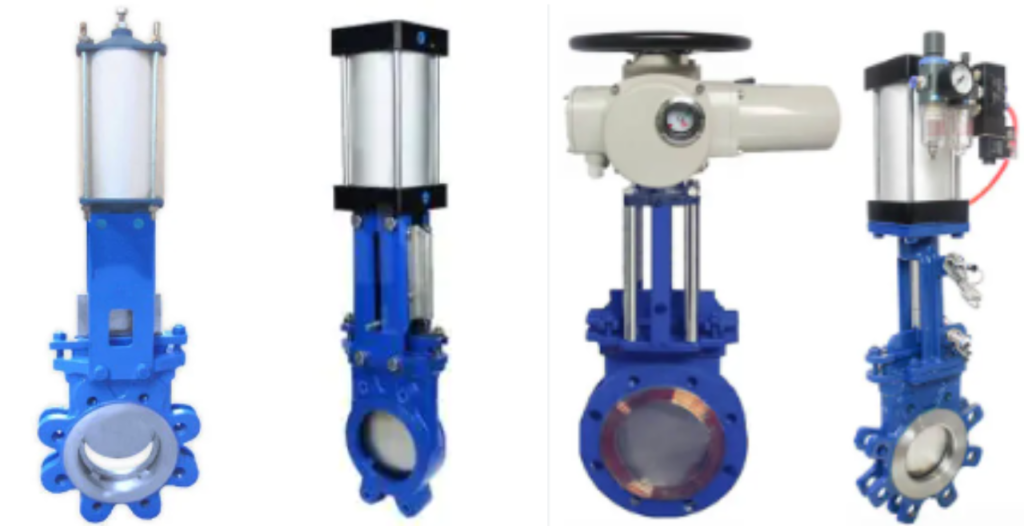SYSTEM COMPONENTS & ACCESSORIES
Knife Gate Valve (KGV) EPO Operated Type
A Knife Gate Valve (KGV) with Electro-Pneumatic Operator (EPO) is a specialized type of industrial valve used for flow control in various applications.
The addition of an electro-pneumatic operator allows for remote or automated control of the valve.
Here’s an overview of the Knife Gate Valve with EPO, including its working process, advantages, disadvantages, applications, materials of construction (MOC), and a summary:
Working Process:
Valve Body: Similar to manually operated KGVs, the valve body of an EPO-operated KGV has a circular or rectangular shape with a gate mechanism inside.
Gate Operation: In this case, an electro-pneumatic actuator is attached to the gate. When an electrical signal is sent to the actuator, it converts it into pneumatic pressure, which is used to move the gate. The gate slides horizontally across the flow path, controlling the flow of the medium.
Control System: The EPO system includes electronic controls that allow for precise positioning of the gate, enabling remote or automated control. Operators can open, close, or modulate the valve as needed.
Sealing Mechanism: Similar to manually operated KGVs, EPO-operated valves often feature a resilient seat or sealing mechanism to ensure a tight seal when the gate is closed.

Advantages:
-
Remote and Automated Control: The EPO system allows for remote operation and automation, which can enhance process control and reduce the need for manual intervention.
-
Precise Flow Control: With the ability to modulate the gate’s position, EPO-operated KGVs are suitable for applications that require precise flow control.
-
Bi-Directional Sealing: Like their manually operated counterparts, many EPO-operated KGVs offer bi-directional sealing, ensuring effective sealing in both flow directions.
-
Suitable for Hazardous Environments: EPO-operated KGVs are suitable for use in hazardous environments, as they can be operated from a safe distance.
Disadvantages:
-
Complexity: The addition of an electro-pneumatic operator makes the valve system more complex and potentially more expensive than manually operated KGVs.
-
Maintenance and Reliability: EPO systems may require more maintenance and can be prone to electrical or pneumatic failures, potentially impacting valve reliability.
Applications: EPO-operated Knife Gate Valves find applications in various industries, including:
- Water and wastewater treatment plants for automated flow control.
- Chemical and petrochemical industries for handling corrosive or hazardous fluids.
- Pulp and paper industries for precise control of pulp and paper stock.
- Food processing for automated handling of viscous or fibrous media.
- Power generation for controlling flow in ash handling systems.
Materials of Construction (MOC): The choice of materials for a Knife Gate Valve with EPO depends on the specific application and the nature of the media being handled. Common materials of construction include:
- Valve Body: Stainless steel, carbon steel, or other corrosion-resistant materials.
- Gate: Stainless steel, carbon steel, or coated with wear-resistant materials.
- Sealing: Elastomers or polymers suitable for the process conditions.
Summary: A Knife Gate Valve with Electro-Pneumatic Operator (EPO) is a specialized valve designed for flow control applications, offering remote or automated control through an electro-pneumatic actuator.
Advantages include precise flow control, automation capabilities, and suitability for hazardous environments.
However, the complexity of the EPO system can lead to higher costs and maintenance requirements.
These valves find use in industries such as water treatment, chemical processing, and power generation, with materials of construction selected based on the specific process requirements


 Sales & Marketing:
Sales & Marketing:  Service Supports:
Service Supports:  Website:
Website: 